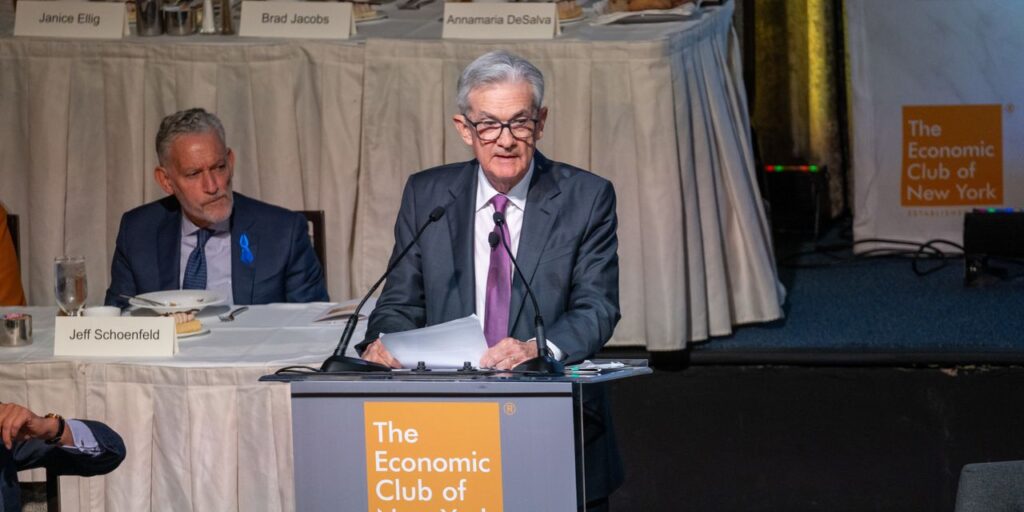The Federal Reserve will hold interest rates steady at its meeting next week, extending the pause that began after the last rate hike in July.
The central bankers are giving off signals that they’d like to remain on the sidelines for some time, but will continue to keep alive the possibility of a hike in December, said Josh Shapiro, chief U.S. economist at MFR Inc.
“They’re not going to do anything. I think that they’re hoping they are done, but I don’t think they are at all ready to commit to that,” Shapiro said.
Stephen Stanley, chief U.S. economist at Santander, agreed the Fed would hold steady: “The FOMC has clearly decided to sit on its hand for another six weeks, hopefully giving time for some of the uncertainties hanging over the outlook to resolve.”
Traders in derivative markets agree. The chances of a rate hike next week have evaporated.
Fed officials will meet on Oct. 31- Nov. 1. The Fed will issue a statement at 2 p.m. Eastern on Wednesday after their meeting ends. Fed Chairman Jerome Powell will hold a press conference at 2:30 p.m.
What are the uncertanties?
There are many uncertainties about the outlook for U.S. inflation and economic growth.
For one, how can the Fed move to the sidelines given recent strong economic data?
U.S. third-quarter GDP accelerated to a 4.9% annual rate and September inflation data was not as sunny as prior reports over the summer, with the core personal consumption expenditure index ticking higher.
“If the policy decision was being made purely based on the economic data, a hike next week would be a slam dunk,” said Stanley.
Carl Tannenbaum, chief economist at Northern Trust Co, said the Fed can hold because their prior rate hikes are starting to bite consumers and businesses.
The rise in long-term bond yields
BX:TMUBMUSD10Y
since the Fed’s meeting in September is the equivalent of a quarter-point rate hike, he added.
The acceleration in GDP was pushed higher by special factors including a boost in inventories. He said the excess savings of consumers was running low and the strong spending seen in July-September was unlikely to be repeated.
The Fed is “more comfortable holding steady than they were three weeks ago,” Tannenbaum said.
Michael Feroli, chief U.S. economist at J.P. MorganChase, agreed that Powell will point to the tighter financial conditions “as a reason to stay on hold.”
“Powell will defend the decision to stand pat by pointing to the tightening in financial conditions and what that implies for the outlook,” Feroli said.
At the same time, the strong data means Powell won’t rule out an additional rate hike this year. The Fed’s dot-plot in September pointed to another hike by December.
Powell will make clear that another hike is going to depend “on what they’re seeing on inflation and the labor market between early November and mid-December,” said Gus Faucher, chief economist of The PNC Financial Services Group.
Powell is likely to continue the Fed’s mantra that interest rates will stay at peak levels for longer than expected.
“Fed officials will be quietly pleased that financial conditions have tightened and will remain sounding hawkish in order not to trigger a reversal of those market moves,” said Michael Pearce, U.S. economist at Oxford Economics.
Could the Fed hike again?
Krishna Guha, vice chairman of Evercore ISI, thinks the strong data “sustain the upside risks case in which the Fed could still get dragged back into hiking further,” either in December or in January or March of next year, with the potential of more than one hike.
“The upside risk of more later from the Fed lingers,” he said.
Derek Holt, head of capital markets economics at Scotiabank, said he was worried that “the whole narrative that is in the market – that inflation has been licked and bonds have done the Fed’s tightening for them” will eventually be reversed by the end of the year or later.
“You can craft a narrative, in my opinion, that says maybe the bond market is oversold and maybe we are declaring victory over inflation prematurely,” Holt said.
He said Powell is aware of this danger and will continue stress doubt over the persistence of the good news on inflation seen over the summer months.
Read the full article here











